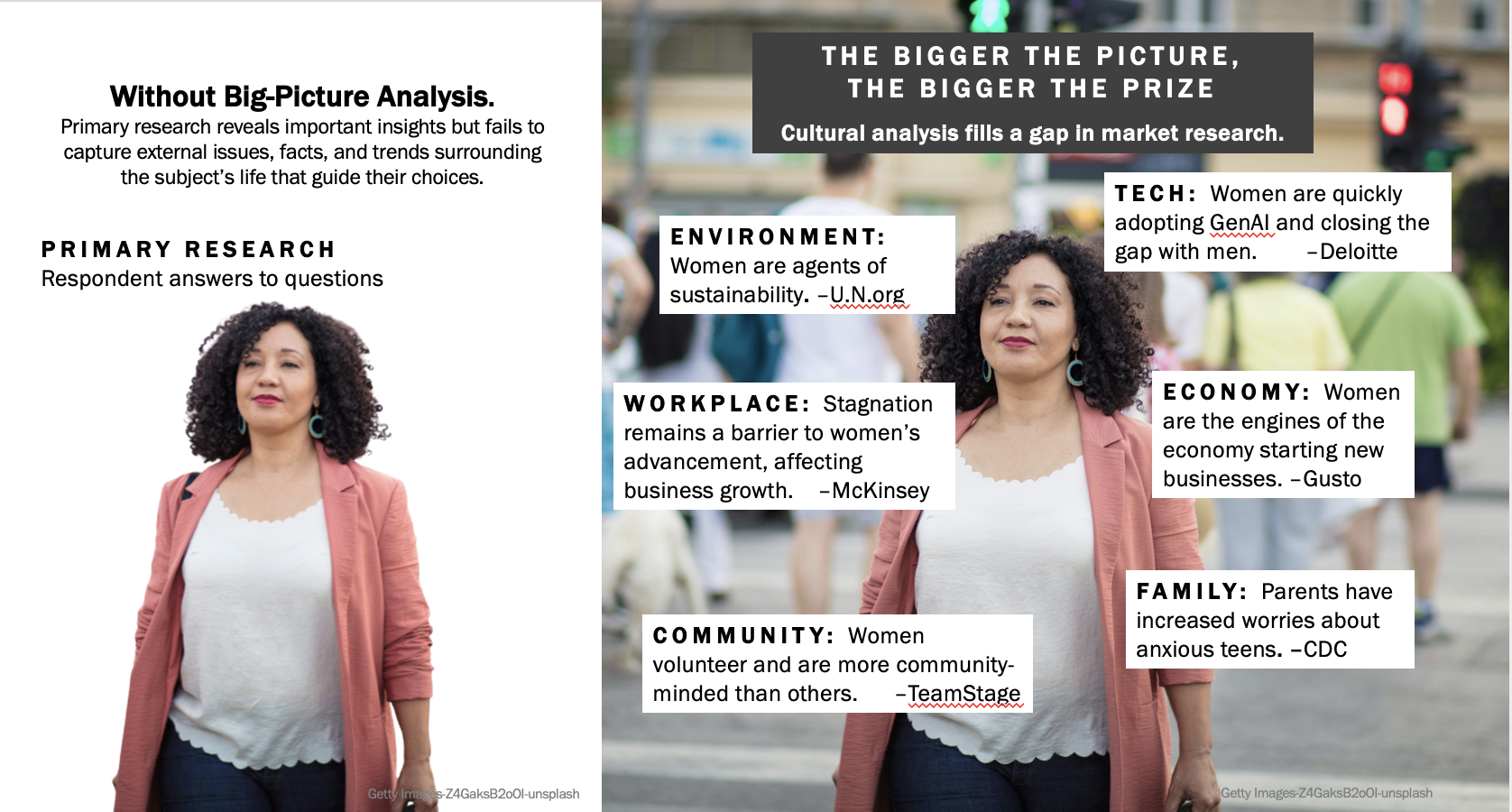No one would intentionally plan a market research project with tunnel vision. But that’s what happens with most research projects putting innovation success at risk. Whether due to budget restrictions or a lack of understanding, most teams begin with primary research conducted through focus groups, ethnographies, online communities, or surveys, that talk directly with consumers. While these are time-honored and important methodologies, they put the cart before the horse, missing everything that influences the consumer in the fuller picture of their lives. And we all know that people don’t always do what they say they do. So why start by asking them what they think or do?
Every day, we engage with the world we live in—the culture—directly and indirectly. People, places, and things move in and out of our world, shaping who we are and what we think, choose, and decide—good or bad. In that sense, we are the product of what we engage with and are exposed to. Ignoring that piece of the research puzzle is to look at half the picture. If you don’t start with the big picture, cultural analysis, you’re left with less understanding and a narrower perspective. You miss out on insight and opportunity that sets the stage for more incisive primary research and a better path to innovation success.
Cultural analysis is secondary research, collecting pre-existing information from various sources like news, studies and reports, trends, media, subject matter experts, museums, universities and advertising. Using a framework like STEEP (Society, Technology, Environment, Economy, and Politics) ensures a holistic perspective on the varied aspects of the culture relevant to the research subject. All this data is then distilled into values, behavior, themes and meaningful insights into the consumer’s life that will influence their decisions about your product or service. This examination of the broader culture reveals the WHY behind the behavior, not just the WHAT, and allows the primary research to connect with consumers on a values and emotional level before you talk about the features and benefits of the product.
Starting with the big picture, with context and cultural analysis, provides an informed starting point for designing research instruments. And when a cross-functional team is involved, everyone is on the same page for the next steps.
Here are a few iconic examples of brands that stepped outside the standard research approach and looked deeper into the cultural lives of their customers changing their brands.
The choices we make
Guinness looked beyond the quality and history of this storied brand to focus on what brings people together to enjoy a pint. The Americans with Disabilities Act, accessibility for all, acceptance and diversity were gaining visibility in the culture. Guinness ditched the worn-out trope of men as party animals and the growing accusation of toxic masculinity, proving men have feelings, too. Instead, Guinness tapped into our better angels in the character of these basketball players in dedication, loyalty and friendship. “The choices we make reveal the true nature of our character.”
Ignite the passion at the core of the brand.
REI tapped into their customers’ shared passion to create an industry-changing campaign. Black Friday had become a competitive event requiring planning and cunning to get the good deals first. Rather than fighting the crowded, nerve-racking and busiest retail day of the year, The #OptOutside campaign encouraged people to do what they love and get outdoors in any way that suited them. Going beyond typical Black Friday deals reminded customers why they shop at REI. Other retailers have since followed suit.
Celebrate what it takes to pursue your sport
Instead of gorgeous pictures of shoes and the technology that went into each model, Nike has focused on the lives and worlds of athletes. One of the best commercials is “Nothing Beats A Londoner.” Purposefully diverse, funny vignettes are strung together in a rollicking few minutes to celebrate the sacrifices, grit, and determination of athletes from all walks of life and what it takes to excel.
In these examples, the brands have new stature they could never have achieved without the big picture cultural analysis. Cultural analysis is not an indulgence. Done with skill and precision, it can transform the business with precise insights that connect on a visceral level, not a rational one.
– Launch your project with cultural analysis and a foundational understanding of the demographic, topic or category.
– Encourage an exchange of ideas about what the findings mean for the project and how they have affected preconceived notions and the hypothesis.
– Incorporate the learnings into the primary research instruments for a better-informed next step.
Combining research methodologies to include the big picture cultural analysis will result in a more comprehensive understanding of customers and effective marketing strategies for innovation success.

